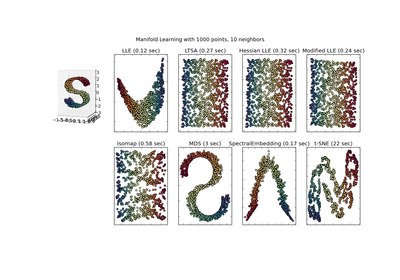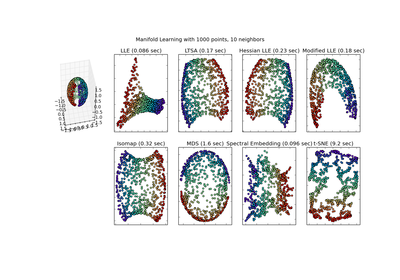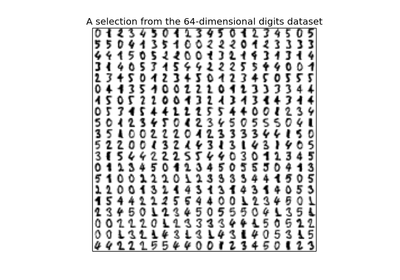sklearn.manifold.Isomap¶
- class sklearn.manifold.Isomap(n_neighbors=5, n_components=2, eigen_solver='auto', tol=0, max_iter=None, path_method='auto', neighbors_algorithm='auto')[source]¶
Isomap Embedding
Non-linear dimensionality reduction through Isometric Mapping
Parameters: n_neighbors : integer
number of neighbors to consider for each point.
n_components : integer
number of coordinates for the manifold
eigen_solver : [‘auto’|’arpack’|’dense’]
‘auto’ : Attempt to choose the most efficient solver for the given problem.
‘arpack’ : Use Arnoldi decomposition to find the eigenvalues and eigenvectors.
‘dense’ : Use a direct solver (i.e. LAPACK) for the eigenvalue decomposition.
tol : float
Convergence tolerance passed to arpack or lobpcg. not used if eigen_solver == ‘dense’.
max_iter : integer
Maximum number of iterations for the arpack solver. not used if eigen_solver == ‘dense’.
path_method : string [‘auto’|’FW’|’D’]
Method to use in finding shortest path.
‘auto’ : attempt to choose the best algorithm automatically.
‘FW’ : Floyd-Warshall algorithm.
‘D’ : Dijkstra’s algorithm.
neighbors_algorithm : string [‘auto’|’brute’|’kd_tree’|’ball_tree’]
Algorithm to use for nearest neighbors search, passed to neighbors.NearestNeighbors instance.
Attributes: embedding_ : array-like, shape (n_samples, n_components)
Stores the embedding vectors.
kernel_pca_ : object
KernelPCA object used to implement the embedding.
training_data_ : array-like, shape (n_samples, n_features)
Stores the training data.
nbrs_ : sklearn.neighbors.NearestNeighbors instance
Stores nearest neighbors instance, including BallTree or KDtree if applicable.
dist_matrix_ : array-like, shape (n_samples, n_samples)
Stores the geodesic distance matrix of training data.
References
[R146] Tenenbaum, J.B.; De Silva, V.; & Langford, J.C. A global geometric framework for nonlinear dimensionality reduction. Science 290 (5500) Methods
fit(X[, y]) Compute the embedding vectors for data X fit_transform(X[, y]) Fit the model from data in X and transform X. get_params([deep]) Get parameters for this estimator. reconstruction_error() Compute the reconstruction error for the embedding. set_params(**params) Set the parameters of this estimator. transform(X) Transform X. - __init__(n_neighbors=5, n_components=2, eigen_solver='auto', tol=0, max_iter=None, path_method='auto', neighbors_algorithm='auto')[source]¶
- fit(X, y=None)[source]¶
Compute the embedding vectors for data X
Parameters: X : {array-like, sparse matrix, BallTree, KDTree, NearestNeighbors}
Sample data, shape = (n_samples, n_features), in the form of a numpy array, precomputed tree, or NearestNeighbors object.
Returns: self : returns an instance of self.
- fit_transform(X, y=None)[source]¶
Fit the model from data in X and transform X.
Parameters: X: {array-like, sparse matrix, BallTree, KDTree} :
Training vector, where n_samples in the number of samples and n_features is the number of features.
Returns: X_new: array-like, shape (n_samples, n_components) :
- get_params(deep=True)[source]¶
Get parameters for this estimator.
Parameters: deep: boolean, optional :
If True, will return the parameters for this estimator and contained subobjects that are estimators.
Returns: params : mapping of string to any
Parameter names mapped to their values.
- reconstruction_error()[source]¶
Compute the reconstruction error for the embedding.
Returns: reconstruction_error : float Notes
The cost function of an isomap embedding is
E = frobenius_norm[K(D) - K(D_fit)] / n_samples
Where D is the matrix of distances for the input data X, D_fit is the matrix of distances for the output embedding X_fit, and K is the isomap kernel:
K(D) = -0.5 * (I - 1/n_samples) * D^2 * (I - 1/n_samples)
- set_params(**params)[source]¶
Set the parameters of this estimator.
The method works on simple estimators as well as on nested objects (such as pipelines). The former have parameters of the form <component>__<parameter> so that it’s possible to update each component of a nested object.
Returns: self :
- transform(X)[source]¶
Transform X.
This is implemented by linking the points X into the graph of geodesic distances of the training data. First the n_neighbors nearest neighbors of X are found in the training data, and from these the shortest geodesic distances from each point in X to each point in the training data are computed in order to construct the kernel. The embedding of X is the projection of this kernel onto the embedding vectors of the training set.
Parameters: X: array-like, shape (n_samples, n_features) : Returns: X_new: array-like, shape (n_samples, n_components) :




